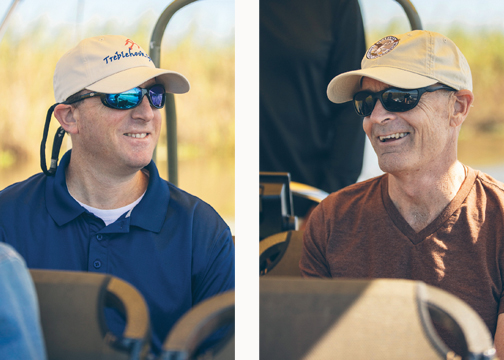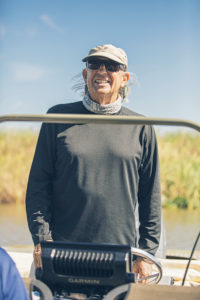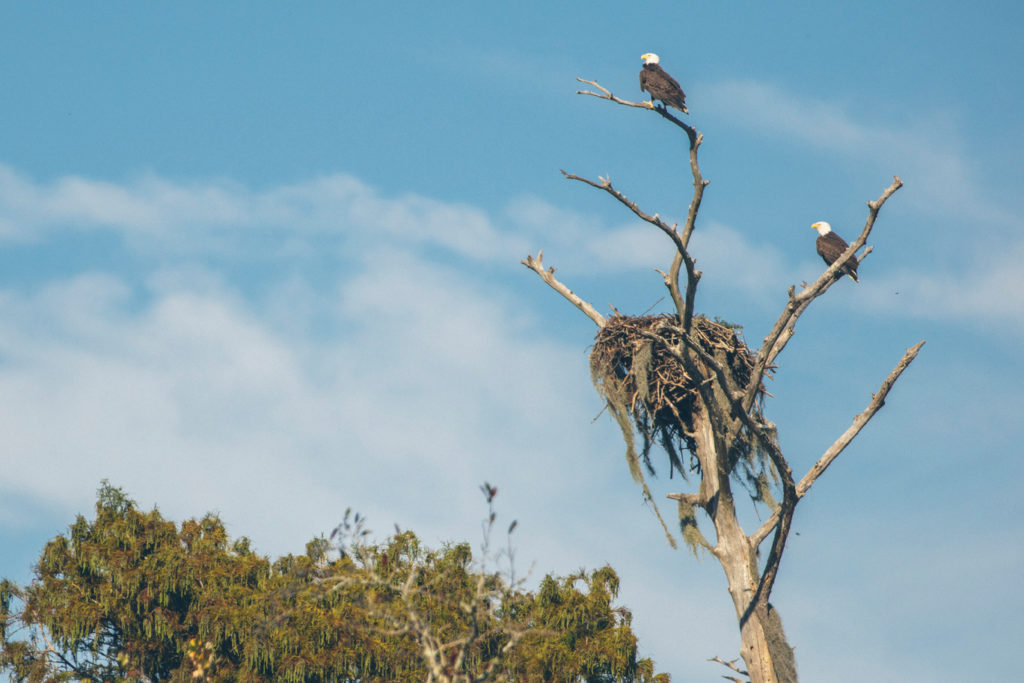
Jack Davis, author of “The Gulf,” came to town on a book promotion in October, and MB hosted a group that took him on a boat tour of the Mobile-Tensaw Delta.
Davis is a professor of history at the University of Florida, specializing in environmental history. “The Gulf: the Making of an American Sea” was published in March 2017, and a year later won a Pulitzer for history. It’s a big book — 565 pages — for a big subject, ranging from Florida to Texas, from prehistory to condo apocalypse.
The natural environments of the Gulf are an essential part of the story, including the region’s 37 estuaries. The estuary that feeds Mobile Bay is one of the largest.
Leading the excursion is Jimbo Meador, a lay expert and extraordinary outdoorsman who owns Delta Excursions. He has been a close observer of these waters for more than six decades. Also along for the journey is author Watt Key, whose novels and essays portray life in and around our waterways.
Setting out from his landing next door to the Bluegill Restaurant on the Causeway, Meador glides us on a ring of the eastern Delta — Chataloochee Bay, Big Bateau and Appalachee River, up to the banks of the historic Blakeley settlement.
Here, from photographer Matthew Coughlin, see postcards of the boatload of like-minded fellows who, each in their own way, protect the legacy of Mobile Bay.



“The Gulf” : A Review

Some reviewers call Davis’s book an “environmental history,” which unfairly minimizes it. This is full-on history. It’s just that he includes the environment as an essential part of the story, in contrast to “the traditional historical narrative that leaves humans gamboling across unacknowledged landscapes, nature erased and dismissed,” as he says in his preface.
The part played by nature is as dramatic as the human players, just not as malevolent as the humans. The humans mostly always get it wrong. From the start, shipwrecked conquistadores, rather than feast on the wealth of seafood that surrounds them, march inland looking for nonexistent beef and end up eating each other.
More than anything, it’s the individuals — both villains and heroes —who stand out the sharpest. They provide the ballast for the long stretch of chronicle.
These are a few, some of my favorites, among just the good guys:
• Field captures the coastal South in keenly observed columns for the New Orleans Times-Picyaune. She is the first woman on the staff, and she uses her pen to champion progressive causes that included mental health reform and women’s rights. Her weekly column capturing Louisiana life makes her a regional media celebrity. Her observations on topics running from hurricanes to fishing camps pop up through the “Gulf” narrative like a series of camera flashes.
• Legendary ethnologist Frank Cushing trains down from Philadelphia late in life to put his spade in at Key Marco Island, Florida. Where Spanish conquistadores began slaughtering what they saw as savage bands of useless oyster eaters, Cushing unfolds an ancient civilization rich in art and permanent settlements. Cushing had invented the role of participant observer by living among the Zuni in New Mexico. On Marco Island, he begins his digging at a pond now known as “Court of the Pile Dwellers.” Piles of oyster shells, that is. Plus more than 1,000 exquisitely carved artifacts, one of the largest troves of indigenous art in the U.S.
• New Orleans’ WDSU TV weatherman Nash Roberts emerges as the final authority on Gulf hurricanes. In the Navy in the Pacific in WWII he was part of a crew that was the first to fly into he eye of a hurricane, gaining insights that helped elude storms and pick off Japanese fleets hit by them. Gulf residents rightly trusted his predictions more than those of the National Weather Service. He accumulated observations from offshore oil platforms as well as barometric data sets. He was the only one to correctly foresee the path of Hurricane Betsy in 1965 and Hurricane Camille four years later. He stayed up for days tracking storms, and his reliability and calm were a refuge to viewers. A retired old man, he spoke at a Camille 30th anniversary event on the Mississippi coast. His lesson from the experience, he told the group: “Go north.”
• Randy Wayne White is built like a wrestler and down from the North seeking liberation in the Florida wilderness. He becomes a fishing guide, an outstanding tarpon hunter and a prolific author of pulp, mostly yarns about an ex-CIA private dick outdoorsman. He’s part of an extensive episode on tarpon fishing that includes a swarm of robber barons, including patent hustler Thomas Edison and his wife, who becomes a record-setting trophy winner. Tarpon are strung up like the lynched, for a flash shot beside slayer. Then trophies evolve to gentlemanly maiming — prying off a fish scale before releasing the tormented to outer darkness. Today’s tarpon hunters, such as White, are self-conscious conservationists. But in the longer scope of history, it was a massacre. Rich sports slaying hundreds of fish in a single vacation, from Captiva, Florida to Padre Island, Texas.
• Artist Walter Anderson is an eccentric of heroic proportions, recreating paradise in an artistic vision heedless of fellow humans and the destruction they are bringing down around their heads. He explores a Blakean heaven on a rusty bicycle, from the mangrove swamps of Florida to the Bohemian French Quarter. He rides out a direct hit by Hurricane Betsy on his beloved Horn Island. He dies of cancer the same year, 1965, after which his most astonishing work is discovered by his wife, unlocking his hermit’s retreat to find “Creation at Sunrise,” a diurnal panorama of a Gulf Coast Eden.
It was Chapter 12, on Anderson, says Davis, that he started his five years of writing “Gulf.” “He showed me how to tell the story,” he says. The subject of a Walter Anderson piece emerges as the center of a vision of the environment that surrounds it, he explains.
The more recent the events, just as predictable is the ugliness created by the Gulf Coast’s human inhabitants. Rivers of manure, pesticide and industrial waste running down to those lacey estuaries, and the Corps of Engineers ditching every rivulet to make it go faster.
The oil industry is covered in colorful detail, from Spindletop to the Deepwater Horizon gusher. Particularly entertaining are the chapters covering Big Oil propaganda, including Jimmy Stewart drilling the first offshore well in “Thunder Bay,” to the Standard Oil-funded fake documentary “Louisiana Story.”
With oil, as with industry and real estate development, it didn’t have to end in disaster. It’s not the oil itself — not even demonized carbon — that is evil. Rather, it’s the human excesses that spill out into the garden.
The story of the Gulf is almost as ageless as that old one that runs from paradise to perdition, and Davis tells it well.
Chris McFadyen is the editor of Business Alabama magazine. He lives in Mobile.





